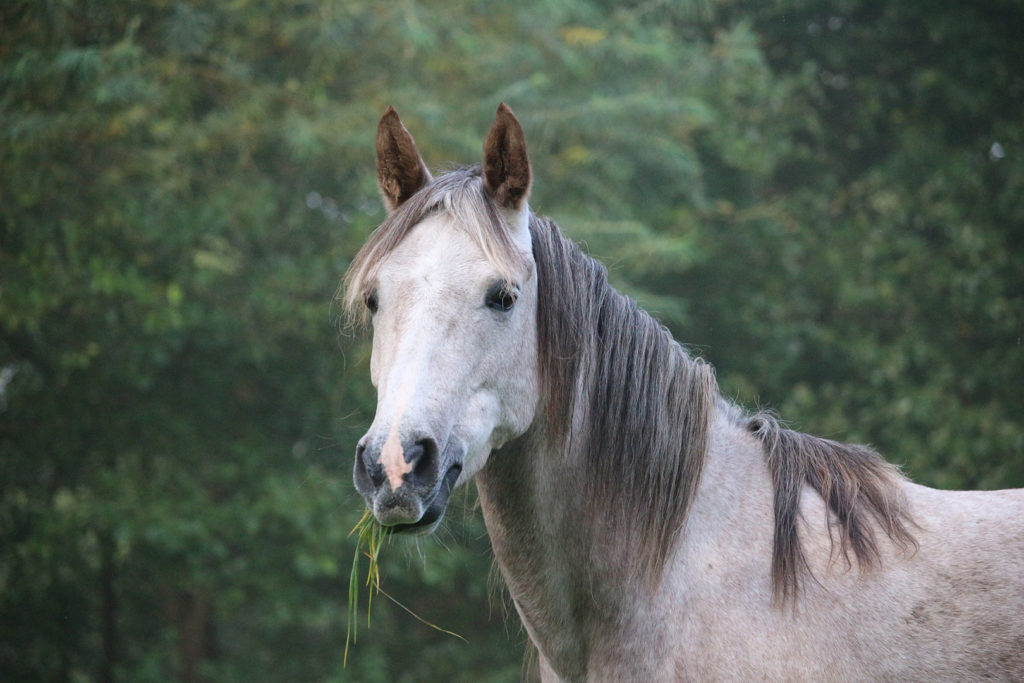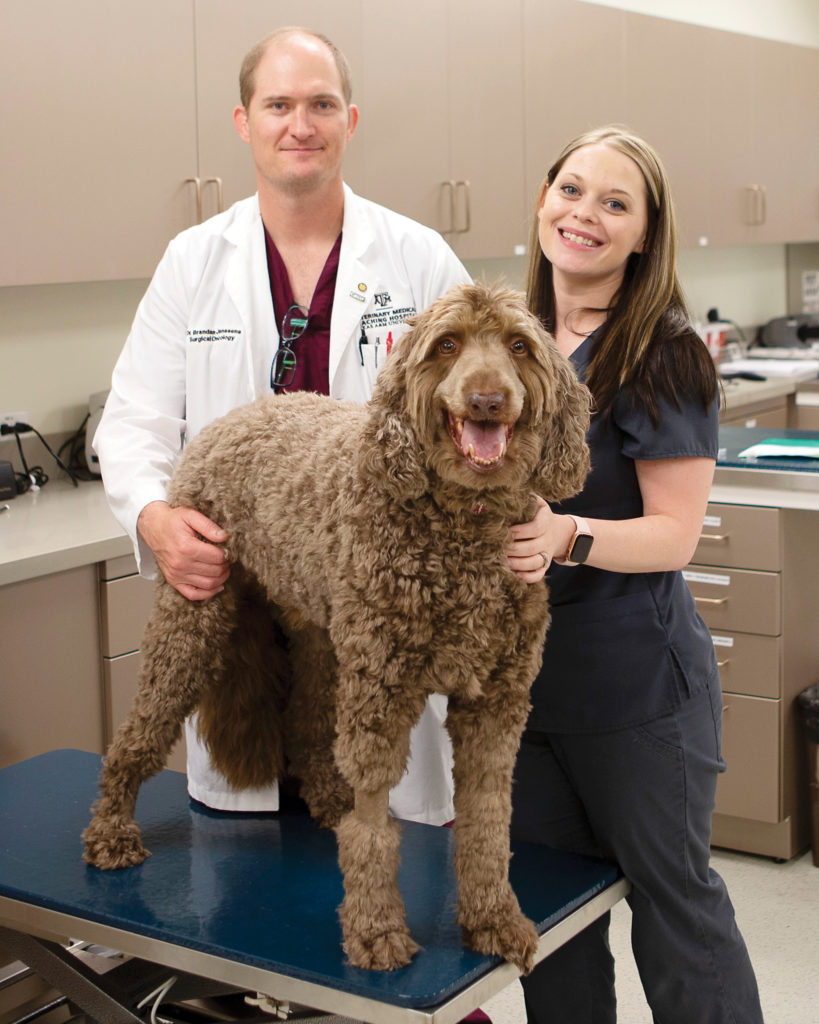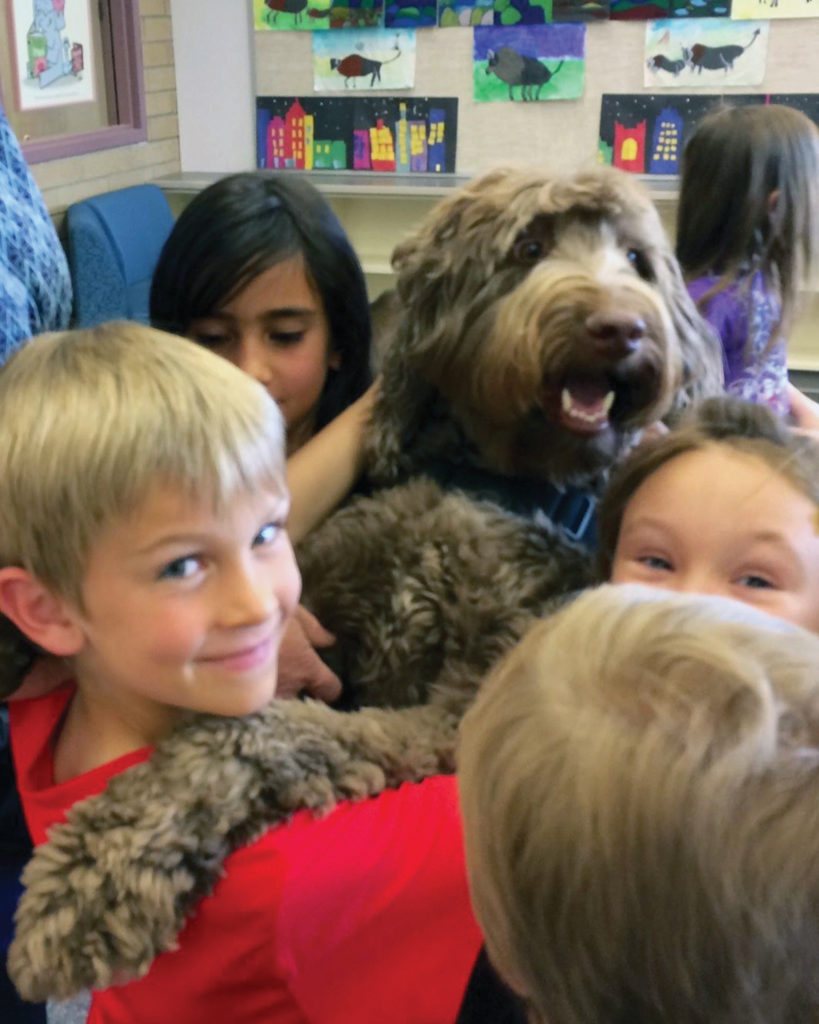A Career Worth Barking About!
https://www.youtube.com/watch?v=jKrOpKtV6Yc
Mary Taylor Erskin, LVN
Transform your love of animals into a career improving the health of animals! Join veterinary technician Mary Taylor Erskin from the Texas A&M Small Animal Teaching Hospital as she describes the pathway to becoming a veterinary technician and career opportunities available in this field. You’ll also get a glimpse into a day in the life of Aggie veterinary technicians. (Grades 6-12)
The Science of Smiles
https://www.youtube.com/watch?v=dAzsrOqCtXs&list=PL3y6sVyaeCRrXlYkfrsgYlpPgfB1RI541&index=50&t=0s
Dr. Bert Dodd
Dr. Bert Dodd, Professor of Small Animal Dentistry at the TAMU Veterinary Teaching Hospital discusses pet dental health. Learn about the structure and function of teeth and how this affects the types of teeth different animals have. Dr. Dodd also explains how to keep your pet’s teeth healthy and why this is important to their overall health. (Grades 4-8)
What Would You Do?: Case
Studies in Science and Ethics
https://www.youtube.com/watch?v=xwnrjtYqmfo&list=PL3y6sVyaeCRrXlYkfrsgYlpPgfB1RI541&index=37&t=0s
Dr. Barbara Gastel
Dr. Barbara Gastel, Professor of Veterinary Integrative Biosciences and Humanities in Medicine at Texas A&M University discusses the ethical implications of scientific research and communication. She will also present real-world scenarios, with difficult ethical choices, from high school, college, and the professional career field. (Grades 10-12)
Keep It Clean!
https://www.youtube.com/watch?v=tze-CpivxN8&list=PL3y6sVyaeCRrXlYkfrsgYlpPgfB1RI541&index=10&t=0s
Dr. Mark Stickney
Dr. Mark Stickney from the Texas A&M Small Animal Teaching Hospital discusses homeostasis, the role of microorganisms in the spread of disease, and how doctors use “aseptic technique” to protect their patients.
(Grades 7-12)
Smart Bird
https://www.youtube.com/watch?v=o0QMzfiX23k
Dr. Ian Tizard
Ian Tizard, Director of the Schubot Exotic Bird Health Center at Texas A&M, discusses the evolution of birds and how this relates to responsible bird ownership. Similar to humans, birds require a total health management plan that includes: physical, mental, and environmental aspects. As Dr. Tizard explains how to meet these unique needs of our feathered friends, students may discover how to improve their own health as well! (Grades 5-9)
Examining Plant and Animal
Cells!
https://www.youtube.com/watch?v=SB-R6WXGAPU&list=PL3y6sVyaeCRrXlYkfrsgYlpPgfB1RI541&index=34&t=0s
Dr. Larry Johnson
Look at vivid microscopic images of the organelles of plant and animal cells (including blood, muscle, and epithelium) and learn about the interaction of cell structure and function. A detailed examination of the cytoplasm and nucleus will reveal how cells differentiate. (Grades 6-9)
Science and You!
https://www.youtube.com/watch?v=jdKC7NPVm6c&list=PL3y6sVyaeCRrXlYkfrsgYlpPgfB1RI541&index=14&t=0s
Dr. Larry Johnson
Discover the many possibilities of science! This presentation defines science, discusses scientific methods, and explores careers in science including engineering, medicine, agriculture, pharmacology, veterinary medicine, and medical research. The many benefits of having a career in science is also discussed, including the travels of a scientist. We show many vet school animal medical specimens as we discuss what scientists do and how they achieve their goals. (Grades 5-8)
Bugs in Your Blood: Malaria!
https://www.youtube.com/watch?v=E7jkAXjFEWI&list=PL3y6sVyaeCRrXlYkfrsgYlpPgfB1RI541&index=30&t=0s
Dr. Jeffery Musser
Dr. Jeffery Musser of the Texas A&M College of Veterinary Medicine discusses the biology of the disease Malaria and its role in history. You will also learn where in the world Malaria occurs and how it can be prevented. (Grades 6-9)
Healthy Pet, Healthy You!
https://www.youtube.com/watch?v=2Zl9PxGBLhE&list=PL3y6sVyaeCRrXlYkfrsgYlpPgfB1RI541&index=9&t=0s
Dr. Mark Stickney
Dr. Mark Stickney from the Texas A&M College of Veterinary Medicine Teaching Hospital will describe important aspects of pet healthcare and the science behind them. From physical exams and vaccinations to nutrition and exercise, veterinarians must be able to apply scientific concepts to ensure the health of our pets! (Grades 5th – 7th)
Nutrition: Food and Digestion
https://www.youtube.com/watch?v=lnFs1LCgCaM
Caitlyn Conner and Emily Schuster
Veterinary students discuss the importance of nutrition for both people and animals, and use a simulated veterinary case study to give a real world application. They also teach a digestion game to demonstrate what happens when digestion works properly and when it functions incorrectly.
(Grades 9-12)
Animal Behavior:
From Wolf to Woof
https://www.youtube.com/watch?v=25vMqnffOpE
Kimberly Jordan and Chanel Berns
Veterinary students explain the history behind domestication of dogs and the science behind animal training. An interactive activity teaches students just how hard it is to teach an old dog new tricks. (Grades 8-12)
Veterinary Emergency Team’s
Response To Bastrop Wildfires
https://www.youtube.com/watch?v=IcdoVjyFBjA
Carin Ponder and Lessa Block
Veterinary technicians Carin Ponder and Lessa Block tell about the Texas A&M University Veterinary Emergency Team and it’s response to the recent wildfires in Bastrop, Texas. They also discuss the training and importance of veterinary technicians in animal health.
The Vet School Experience: What is vet school really like?
https://www.youtube.com/watch?v=yLJdDbsFXVI&list=PL3y6sVyaeCRp3eB1TxoDgW8fais5036eM&index=17&t=5s
Nikki Lejeune, Emily Burkhart, and Dr. Anton Hoffman, D.V.M.
Second, and third year veterinary students host an interactive panel, taking students’ questions regarding what being in veterinary school is really like. Also answering questions is Dr. Anton Hoffman, a professor at the Texas A&M Vet School. Questions are taken from a live feed and answered by the vet students according to their own experiences.
My Path to Vet School: A
Veterinary Student Q&A Panel
https://www.youtube.com/watch?v=q9lIe1da0rw&list=PL3y6sVyaeCRp3eB1TxoDgW8fais5036eM&index=16&t=0s
Nikki Lejeune, Clarissa Root, and
Chanel Berns
First, second, and third year veterinary students host an interactive panel, taking students’ questions regarding preparing for vet school as well as the application process. Questions are taken from a live feed and answered by the vet students according to their own experiences.
The Cat’s Out of the Bag! –
Veterinary Specialization
and Feline Medicine
https://www.youtube.com/watch?v=AiTbFK6mIig&list=PL3y6sVyaeCRrXlYkfrsgYlpPgfB1RI541&index=49&t=0s
Dr. John August
Dr. John August discusses how the evolution of cats, their response to stimuli, and the effects of their environments make them unique and challenging patients.
Love Your Lungs!
https://www.youtube.com/watch?v=TTszMoA2LzY&list=PL3y6sVyaeCRrXlYkfrsgYlpPgfB1RI541&index=39&t=0s
Dr. Larry Johnson
Dr. Johnson describes and demonstrates the structure and function of the respiratory system with anatomical specimens, models, and demonstrations. Students learn how we breathe and how much air our lungs hold. They also observe how smoking affects cell function, appearance and condition of the lung and learn about its possible role in causing lung cancer.
Your Vet Can Name It –
Cell Theory and Taxonomy
https://www.youtube.com/watch?v=cjQQ-Hm5QJA
Sandra Martin
Veterinary Student, Sandra Martin, provides a short review of cell theory and a basic overview of taxonomy. She discusses how this information is used in veterinary medicine; answering the age-old question “Why do we need to know this?”
Protecting the Human Herd
https://www.youtube.com/watch?v=N8tBhVtP86M&list=PL3y6sVyaeCRrXlYkfrsgYlpPgfB1RI541&index=24&t=0s
Dr. Meredyth Jones
Dr. Meredyth Jones from the Texas A&M Large Animal Teaching Hospital describes how to protect the human herd by keeping individuals healthy. This presentation includes factors contributing to disease within a community as well as management techniques to prevent or reduce the spread of disease.
Cell Structure and
Function in You
https://www.youtube.com/watch?v=ae1sUnqolM8
Dr. Larry Johnson
Students are able to see how cell structure and function impacts their body’s ability to carry out all of life’s demands. Dr. Johnson shows vivid microscopic images of the organelles of both plant and animal cells and discusses the interaction of cell structure and function.
How I Got Into
Veterinary School!
https://www.youtube.com/watch?v=CBJ90J5okEM&list=PL3y6sVyaeCRp3eB1TxoDgW8fais5036eM&index=3&t=0s
Devin Smith
Third year veterinary student, Devin Smith, gives students an insider’s perspective on preparing for, applying, and getting into veterinary school.
My Path To Medical School
https://www.youtube.com/watch?v=KkaW8JI-XrE&t=12s
Katherine Laky
Katherine Laky is a senior Biomedical Science major in the College of Veterinary Medicine and Biomedical Sciences. Katherine shares her personal experiences preparing and applying for medical school, as well as her journey through eleven medical school interviews. These interviews include all nine Texas medical schools as well as Harvard Medical School and Mayo Medical School. Katherine includes helpful advice for applying and interviewing, as well as school-specific information. This video is aimed toward pre-medical undergraduate students; however, other students with medical interest may find this information valuable as well.
Wildlife Health
https://www.youtube.com/watch?v=7YfRu_8TyxM&list=PL3y6sVyaeCRrXlYkfrsgYlpPgfB1RI541&index=23&t=0s
Dr. Alice Blue- McClendon
Dr. Alice Blue-McClendon, director of the Winnie Carter Wildlife Center at Texas A&M University, provides insights into the role that wildlife plays for the health and benefit of humans.
Anatomy and Physiology
https://www.youtube.com/watch?v=wNYM_WWIwRo&list=PL3y6sVyaeCRrXlYkfrsgYlpPgfB1RI541&index=36&t=0s
Dr. Larry Johnson
The presentation provides an overview of anatomy and physiology. The different types of cells, tissues, organs, and organ systems and their structures and functions in the human body and other living organisms will be discussed. Additionally, we define anatomy and physiology, learn about the fields of anatomy, look at the four types of tissues, and see the Integumentary, Musculoskeletal, Lymphatic, and Immune systems. Veterinary anatomy specimens are used.
Veterinary Technicians 101
https://www.youtube.com/watch?v=ek61qeMw3Wo
Caleb Coursey, Lauren Minner, Juan
Torres, and Hollye Callis
Do you love animals? Would you like to have a career caring for animals? Join veterinary technicians from the Texas A&M College of Veterinary Medicine & Biomedical Sciences as they describe the pathway to becoming a veterinary technician and career opportunities available in this field. You’ll also get a glimpse into the on-the-job activities of several veterinary technicians working in the Small Animal Hospital at Texas A&M University.
Living with Bugs: Symbiosis
with Microbes
https://www.youtube.com/watch?v=j7OzyBg93Ak&list=PL3y6sVyaeCRrXlYkfrsgYlpPgfB1RI541&index=38&t=0s
Dr. Ian Tizard
We live in a world full of microbes – bacteria and viruses! Our skin and other surfaces are densely inhabited by bacteria. We have more bacteria in our intestines than cells in our bodies! Bacteria help us digest food, help us develop resistance to infections and help control the development of allergies. Only when bacteria try to invade our bodies do they present a threat. Learn how humans and our microbes cooperate to maintain us in good health and to see what might happen when things go wrong..
Animal Behavior: Decoded!
https://www.youtube.com/watch?v=cqcpK3m2woo
Devin Smith
This presentation by veterinary students at Texas A&M University explores important animal behavior questions. How do I know when my pet is feeling happy, anxious, or aggressive? What do I do if I encounter a wild animal? What is rabies, and why do we need to vaccinate our pets against it? This is a fun and interactive presentation where students learn some of the many ways animals can communicate with humans.
Orthopedics: Down to the
Bone!
https://www.youtube.com/watch?v=GafhUsv-iJY
Beverly Crocker
In this presentation, students learn all about what bones are and how they function for the human and animal body and discover what fractures are and how the body can fix them. They also become informed about innovative new research that is helping humans with bone disorders. Veterinary students from Texas A&M University use anatomy specimens and radiographs to show students the skeleton in a way they have never seen before.
The Scoop On Nutrition
https://www.youtube.com/watch?v=OtlXF6Ugue8&list=PL3y6sVyaeCRrXlYkfrsgYlpPgfB1RI541&index=48&t=0s
Leslie Wagner
This presentation covers the meaning of nutrition, explores the impact nutrition has on the health of our animals, and discusses the consequences associated with poor nutrition. We discuss how nutrition can be our first line of defense against the serious issues of obesity and diabetes, and how we can live happier, healthier lives with our pets. Veterinary anatomy specimens are used to show parts of the digestive system.
Anatomy and Physiology
(Part 1)
https://www.youtube.com/watch?v=GOZg-HPyLzs&list=PL3y6sVyaeCRrXlYkfrsgYlpPgfB1RI541&index=47&t=0s
Dr. Larry Johnson
This presentation provides an overview of anatomy and physiology. The different types of cells, tissues, organs, and organ systems and their structures and functions in the human body and other living organisms are discussed. In Part 1, define anatomy and physiology, learn about the fields of anatomy, look at the four types of tissues, and see the Integumentary, Musculoskeletal, Lymphatic, and Immune systems. Veterinary anatomy specimens are used in this presentation.
Anatomy and Physiology
(Part 2)
https://www.youtube.com/watch?v=GD-wHw2dPOA&list=PL3y6sVyaeCRrXlYkfrsgYlpPgfB1RI541&index=46&t=0s
Dr. Larry Johnson
This presentation will take a close look at the Digestive, Respiratory, Cardiovascular, Urinary, Nervous, Endocrine, and Special Systems (Senses). Veterinary anatomy specimens will be used to show the structures of the systems and there will be interactive activities for the students!
Don’t let the bugs bite: Our
battle against the microbes that
want to eat us!
https://www.youtube.com/watch?v=svYj9485DQI&list=PL3y6sVyaeCRrXlYkfrsgYlpPgfB1RI541&index=45&t=0s
Dr. Ian Tizard
We live in a microbial world which is occupied by enormous numbers of bacteria and viruses. For many microbes, we present an irresistible source of food and shelter. To survive and live healthy lives we must defend against these bugs. The immune system (which is essential for life) is a complex, many layered system of defense that begins at the body’s surface and extends throughout all our tissues and is able to handle a diverse array of attacking microbes at any one time. Sometimes we assist in this battle and enhance our immunity by the use of vaccines. We will discuss the immune system using common disease examples such as AIDS and influenza.
Large Animal Veterinary
Technicians
https://www.youtube.com/watch?v=qGx0KRleobM&list=PL3y6sVyaeCRrXlYkfrsgYlpPgfB1RI541&index=22&t=0s
Sheila Gibler and Sandra Nunn
What do you do when your patients whinny, squeal, or moo? Join veterinary technicians Sandra Nunn and Sheila Gibler from the Large Animal Hospital at the Texas A&M College of Veterinary Medicine& Biomedical Sciences as they describe the unique aspects of large animal veterinary medicine and career opportunities available in this field. These technicians will also provide personal perspectives about working in equine and food animal services.
Living with Bugs!
https://www.youtube.com/watch?v=j7OzyBg93Ak&list=PL3y6sVyaeCRrXlYkfrsgYlpPgfB1RI541&index=38&t=0s
Dr. Ian Tizard
We live in a world full of microbes – bacteria and viruses! Our skin and other surfaces are densely inhabited by bacteria. We have more bacteria in our intestines than cells in our bodies! Current research has shown that we interact in many different ways with our internal “bugs.” Join us to see how humans and our microbes cooperate to maintain us in good health and to see what might happen when things go wrong.
Modern Careers in Veterinary Medicine
https://www.youtube.com/watch?v=yMu6r37UACI
Dr. Mark Stickney
Dr. Mark Stickney from the Texas A&M Small Animal Teaching hospital describes the many career opportunities of veterinarians and professionals which often work with veterinarians
Chew on This: Monogastrics and Hindgut Fermenters
https://youtu.be/IduOjxkCogk
Dr. Carly Patterson
Dr. Carly Patterson, Clinical Assistant Professor at the Texas A&M College of Veterinary Medicine and Biomedical Sciences, takes us on a tour of the digestive systems of various species. She explains the differences in monogastric, hindgut fermenters (modified monogastric species), and ruminant animals. Additionally, the function and appearance of each section of the monogastric digestive tract is described, along with special adaptations that hindgut fermenters have developed through evolution.
 As a third-year veterinary student, I have been
As a third-year veterinary student, I have been








 Recently, interest has arisen surrounding grain-free diets and their impact on canine health.
Recently, interest has arisen surrounding grain-free diets and their impact on canine health.




